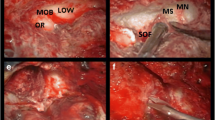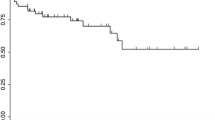Abstract
Intracranial meningiomas mostly affect patients in their fifth decade and beyond, raising pertinent questions regarding the risk of surgery, particularly in the elderly. Here, we describe the case of a septuagenarian patient with occipital meningioma causing severe visual field cuts that experienced full recovery of the visual function after a Simpson I resection of the lesion. This case illustrates the potential of recovery of the brain, even in the case of severely impaired function in elderly patients. To complete the picture, we review the literature on occipital meningiomas, advocating for systematic reports and increase data collection on post-operative neurological recovery in the elderly.


Similar content being viewed by others
References
Abe Y, Maruyama K, Yokoya S, Noguchi A, Sato E, Nagane M, Shiokawa Y (2017) Outcomes of chronic subdural hematoma with preexisting comorbidities causing disturbed consciousness. J Neurosurg 126:1042–1046. https://doi.org/10.3171/2016.3.JNS152957
Abuleil D, McCulloch DL, Thompson B (2019) Older adults exhibit greater visual cortex inhibition and reduced visual cortex plasticity compared to younger adults. Front Neurosci 13:607. https://doi.org/10.3389/fnins.2019.00607
Bommakanti K, Somayajula S, Suvarna A, Purohit AK, Mekala S, Chadalawadi SK, Gaddamanugu P (2016) Pre-operative and post-operative cognitive deficits in patients with supratentorial meningiomas. Clin Neurol Neurosurg 143:150–158. https://doi.org/10.1016/j.clineuro.2016.02.033
Brodbelt AR, Barclay ME, Greenberg D, Williams M, Jenkinson MD, Karabatsou K (2019) The outcome of patients with surgically treated meningioma in England: 1999-2013. A cancer registry data analysis. Br J Neurosurg 33:641–647. https://doi.org/10.1080/02688697.2019.1661965
Corell A, Thurin E, Skoglund T, Farahmand D, Henriksson R, Rydenhag B, Gulati S, Bartek J Jr, Jakola AS (2019) Neurosurgical treatment and outcome patterns of meningioma in Sweden: a nationwide registry-based study. Acta Neurochir 161:333–341. https://doi.org/10.1007/s00701-019-03799-3
Dobran M, Marini A, Nasi D, Liverotti V, Benigni R, Costanza MD, Mancini F, Scerrati M (2019) Clinical outcome of patients over 90 years of age treated for chronic subdural hematoma. J Korean Neurosurg Soc. https://doi.org/10.3340/jkns.2018.0011
Ghanimi Zamli AK, Chew-Ean T, Wan Hitam WH (2019) Bilateral inferior altitudinal visual field defect in recurrent intracranial meningioma: a case report. Cureus 11:e4436. https://doi.org/10.7759/cureus.4436
Goldbrunner R, Minniti G, Preusser M, Jenkinson MD, Sallabanda K, Houdart E, von Deimling A, Stavrinou P, Lefranc F, Lund-Johansen M, Moyal EC, Brandsma D, Henriksson R, Soffietti R, Weller M (2016) EANO guidelines for the diagnosis and treatment of meningiomas. Lancet Oncol 17:e383–e391. https://doi.org/10.1016/S1470-2045(16)30321-7
Golub D, Mehan ND, Kwan K, Salas SJ, Schulder M (2019) Supracerebellar transtentorial approach for occipital meningioma to maximize visual preservation: technical note. Oper Neurosurg (Hagerstown) 17:E177–E183. https://doi.org/10.1093/ons/opy380
Hasseleid BF, Meling TR, Ronning P, Scheie D, Helseth E (2012) Surgery for convexity meningioma: Simpson grade I resection as the goal: clinical article. J Neurosurg 117:999–1006. https://doi.org/10.3171/2012.9.JNS12294
Islim AI, Mohan M, Moon RDC, Rathi N, Kolamunnage-Dona R, Crofton A, Haylock BJ, Mills SJ, Brodbelt AR, Jenkinson MD (2020) Treatment outcomes of incidental intracranial meningiomas: results from the IMPACT cohort. World Neurosurg. https://doi.org/10.1016/j.wneu.2020.03.060
Konglund A, Rogne SG, Helseth E, Meling TR (2013) Meningioma surgery in the very old-validating prognostic scoring systems. Acta Neurochir 155:2263–2271; discussion 2271. https://doi.org/10.1007/s00701-013-1872-0
Konglund A, Rogne SG, Lund-Johansen M, Scheie D, Helseth E, Meling TR (2013) Outcome following surgery for intracranial meningiomas in the aging. Acta Neurol Scand 127:161–169. https://doi.org/10.1111/j.1600-0404.2012.01692.x
Lassen B, Helseth E, Ronning P, Scheie D, Johannesen TB, Maehlen J, Langmoen IA, Meling TR (2011) Surgical mortality at 30 days and complications leading to recraniotomy in 2630 consecutive craniotomies for intracranial tumors. Neurosurgery 68:1259–1268; discussion 1268-1259. https://doi.org/10.1227/NEU.0b013e31820c0441
Le Beau J, Wolinetz E, Rosier M (1952) Phenomenon of the preservation of visual images in a case of right occipital meningioma. Rev Neurol (Paris) 86:692–695
Lehmann G, Bremond J, Rabaud C, Paillas JE (1975) Space-occupying lesions of the occupital lobe of the cerebral cortex. Neurochirurgie 21:55–79
Liouta E, Koutsarnakis C, Liakos F, Stranjalis G (2016) Effects of intracranial meningioma location, size, and surgery on neurocognitive functions: a 3-year prospective study. J Neurosurg 124:1578–1584. https://doi.org/10.3171/2015.6.JNS1549
Macarez R, Bazin S, Civit T, Grubain S, de la Marnierre E, Huu DT, Guigon B (2003) Postoperative visual improvement in spheno-orbital meningioma: a case report. J Fr Ophtalmol 26:375–380
Matavulj N, Thiebaut F (1956) Study of the visual field following removal of an occipital meningioma. Rev Otoneuroophtalmol 28:88–91
Munoz-Bendix C, Pannewitz R, Remmel D, Steiger HJ, Turowski B, Slotty PJ, Kamp MA (2017) Outcome following surgical treatment of chronic subdural hematoma in the oldest-old population. Neurosurg Rev 40:461–468. https://doi.org/10.1007/s10143-016-0803-y
Patra DP, Savardekar AR, Dossani RH, Narayan V, Mohammed N, Nanda A (2018) Meningioma: the tumor that taught us neurosurgery. World Neurosurg 118:342–347. https://doi.org/10.1016/j.wneu.2018.06.017
Pauwels L, Chalavi S, Swinnen SP (2018) Aging and brain plasticity. Aging (Albany NY) 10:1789–1790. https://doi.org/10.18632/aging.101514
Rogne SG, Konglund A, Meling TR, Scheie D, Johannesen TB, Ronning P, Helseth E (2009) Intracranial tumor surgery in patients >70 years of age: is clinical practice worthwhile or futile? Acta Neurol Scand 120:288–294. https://doi.org/10.1111/j.1600-0404.2009.01157.x
Umemura T, Hachisuka K, Miyachi H, Nishizawa S, Yamamoto J (2020) Clinical outcomes of cerebral infarction in nonagenarians compared among four age groups. Neurol Sci. https://doi.org/10.1007/s10072-020-04348-y
Uno M, Toi H, Hirai S (2017) Chronic subdural hematoma in elderly patients: is this disease benign? Neurol Med Chir (Tokyo) 57:402–409. https://doi.org/10.2176/nmc.ra.2016-0337
Wright AD (1939) Tumours of the parietal and occipital lobes. Postgrad Med J 15:179–182. https://doi.org/10.1136/pgmj.15.163.179
Author information
Authors and Affiliations
Contributions
Data collection: M.V.C., T.R.M.
Review of the literature: M.V.C.
Manuscript drafting: M.V.C.
Critical revision: all authors
Corresponding author
Ethics declarations
Conflict of interest
The authors declare that they have no conflict of interest.
Ethical approval
All procedures performed in studies involving human participants were in accordance with the ethical standards of the institutional and/or national research committee (CCER/2020-00235) and with the 1964 Helsinki declaration and its later amendments or comparable ethical standards.
Informed consent
For this type of study, formal consent is not required.
Additional information
Publisher’s note
Springer Nature remains neutral with regard to jurisdictional claims in published maps and institutional affiliations.
Submission statement
The present work is original and has not been submitted elsewhere in part or whole.
This article is part of the Topical Collection on Brain Tumors
Rights and permissions
About this article
Cite this article
Corniola, M.V., Bouthour, W., Vargas, MI. et al. Visual field restoration after Simpson grade I resection of symptomatic occipital lobe meningioma: illustrative case and review of the literature. Acta Neurochir 163, 67–71 (2021). https://doi.org/10.1007/s00701-020-04569-2
Received:
Accepted:
Published:
Issue Date:
DOI: https://doi.org/10.1007/s00701-020-04569-2




